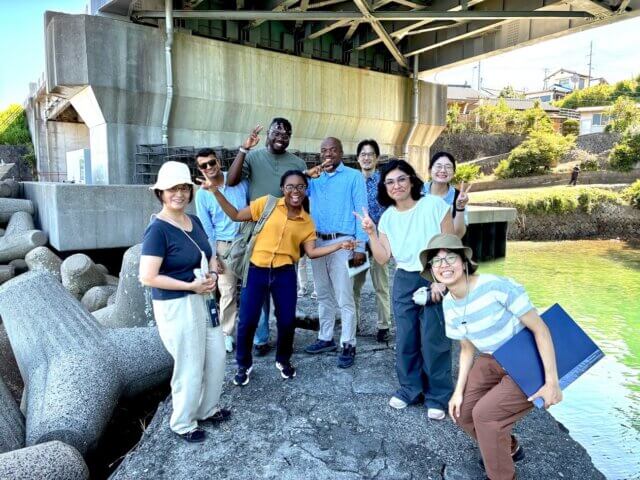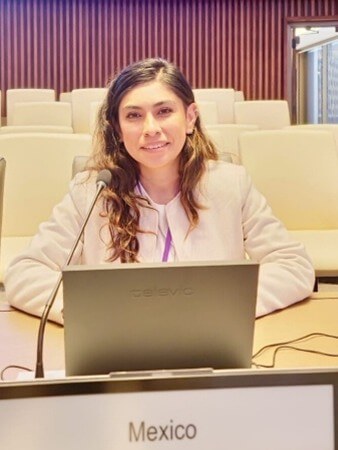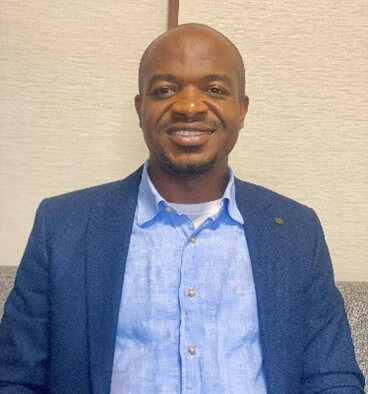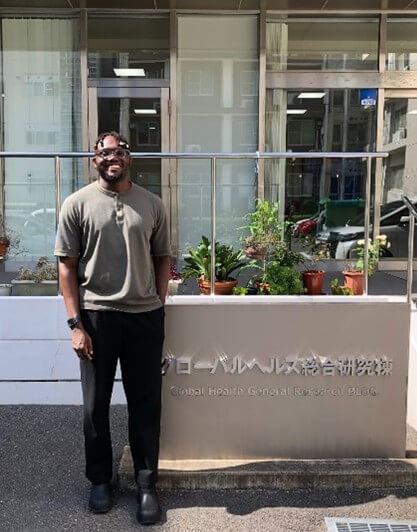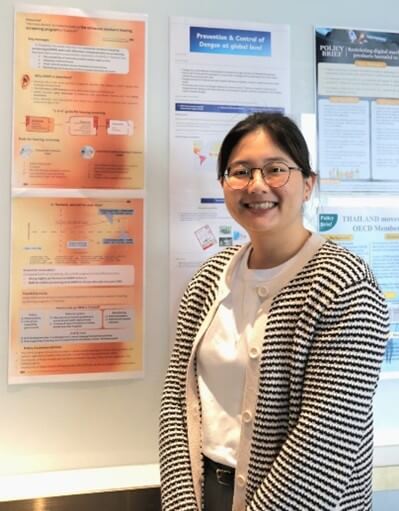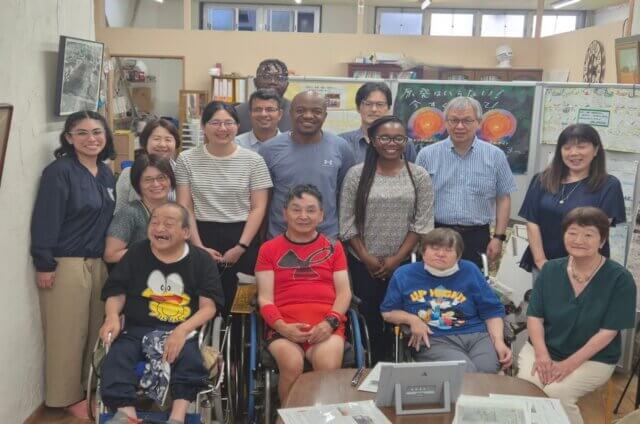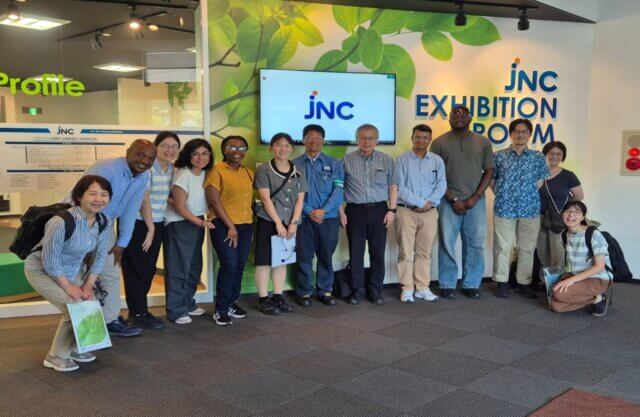In the Doctor of Public Health (DrPH) program under the Interfaculty Initiative in Planetary Health (IIPH), a three-day, two-night Minamata Field Trip is held annually during the fourth quarter of the first year.
Through the study of Minamata Disease, which occurred during Japan’s period of rapid economic growth, students learn about the responsibilities of public health professionals and the complex relationships among health, environment, society, and policy.
Prior to the trip, students participate in preparatory lectures and film sessions, followed by an on-site field study in Minamata City, Kumamoto Prefecture, accompanied by several faculty members.
During the fieldwork, students engage in discussions with patients, supporters, and researchers, and visit related facilities to explore:
- The causes and background of Minamata Disease
- The social and political contexts surrounding its outbreak
- The responses and challenges faced by the government and industry
- The current situation and future issues
Students are encouraged to reflect on how the lessons from Minamata Disease can be applied to other environmental and public health problems.
This year’s field trip was held from July 21 to 24, and we are pleased to share reflections written by participating students.
Prakash Chandra Bhatta
DrPH Student, IIPH
Minamata City as an Environmental Model City-A example for Public Private partnership and community participation
The first reported case of Methyl-mercury poisoning was officially confirmed in 1956. In 1990, 34 years after the Minamata disease conformation, Minamata City launched the “Minamata Environment Generation Project.”1In 1992, Minamata was the first city in Japan to formally declare its ambition to become an “Environmental Model City” and launched full-fledged efforts to build a city founded on environmental protection and utilizing the lessons learned from Minamata disease.
- Waste Management:
Introduced in 1993, types of waste separation in Minamata city reached from 2 types (burnable & non-burnable) to 24 types in 2024 through recycle promotion committee members available at 309 stations, who assist in sorting and promoting community engagement.
- Economic Share-back Model (waste to wealth- promoting community participation):
Profits from the sale of recyclable garbage are returned to local communities as recycling returns. Each district receives according to the weight of each district’s recyclable garbage; large districts receive up to 600,000 yen a year and smaller districts about 70,000-80,000 yen, which supports funding for community upkeep and events. In 2023, approximately 14,656,852-yen profit was gained from resources. To raise awareness and to promote reuse, the city government concluded an agreement with Jimoty Ltd (a reusable sales company).
- Eco-Town Project:
The Minamata Eco-town plan concept has become a model for small and medium-sized cities nationwide. This project includes tripartite cooperation among citizens, government and industries. Under the Eco Town Plan (approved 2001) by the Ministry of Environment and METI, Minamata to promote the “zero emission concept (Zero waste). They built the Eco Town industrial park, anchored by the Minamata Environmental Technology Center. This supports companies that recycle bottles, electronics, tires, plastics, waste oil, and sewage into reusable products (e.g. fertilizers, resin feedstock) and provides opportunities for local jobs. This City’s comprehensive plan has addressed environmental, Society and Economy for building sustainable community.
- Promoting Moyainaoshi:
After 24 years of Minamata disease, City government held “moyainaoshi” meaning to regain the bond and social trust between citizens via shared environmental goals to bound the fragmented local communities due to the outbreak. The initiative includes support for Minamata disease victims, Memorial Services (monument, fire-festival), Educational promotion initiatives and dialogues.
- Promoting SDG:
Community-led recycling projects, the city’s self-declaration of compliance to international standards for environmental management systems corresponding to audits by citizens, promotion of zero-waste measures, and other programs encouraged citizens to practice eco-friendly actions in their daily lives.3 Minamata’s experience toward becoming an environmental model city will accelerate global initiatives for Sustainable Development Goals (SDGs) by passing shared values for sustainability and health from generation to generation.
Through these innovative waste management, citizen-led recycling, and strategic environmental planning efforts Minamata City transformed its industrial-pollution legacy into a profitable, sustainable model of local renewal, aligning economic return with ecological stewardship which have been highly praised, and Minamata City has become a model for many local governments and environmental groups in Japan and abroad, and many people involved have come to visit the city like we visited this year. For these efforts, in 2008, 17 years after the declaration, it was selected as one of the six municipalities certified by the government as an “environmental model city” for the first time. Furthermore, in 2011, it won the title of the only “Japan’s Environmental Capital”.
Mavis Sakyi
DrPH Student, IIPH
Tragedy in Minamata: A Testament to Human Resilience, Hope and Environmental Activism
Our educational visit to Minamata City from July 21 to 23, 2025 was an insightful one. I had the privilege of witnessing firsthand the devastating effects of methylmercury-driven environmental pollution and was reminded of the profound impact that human actions can have on our planet. The experience of Minamata disease (MD)is a stark reminder that the consequences of neglecting the environment at the expense of the economy or for any other reason can be catastrophic, affecting not only individuals and communities in the present period but also future generations. In the past seven decades, the Chisso factory’s promise of industrial revolution and economic growth has given way to a long-standing nightmare for communities in Japan.
The dumping of untreated industrial waste, specifically methylmercury-polluted waste, in Minamata Bay and River, combined with the delayed responsiveness of government agencies and persistent myths and misconceptions surrounding Minamata disease, created a public health emergency that has endured for generations.
This was seen in the inspiring stories of the persons living with fetal MD. However, even amid tragedy, there is hope. The response to Minamata disease has been a testament to humanity’s capacity for self-organization and evolution. Research like those of Prof. Mineshi Sakamoto and its translation into policy provided a foundation for data-driven decision making especially for pregnant women during MD, while surveillance activities have improved communities’ plight.
Moreover, the government’s efforts to turn Minamata City into the most eco friendly city in Japan over the past decades demonstrate a commitment to planetary health. One of the most striking aspects of the visit for me was the courage and resilience of Mr. Masami Ogata, a certified Minamata disease patient who has dedicated his life to advocacy and community healing. His story serves as a powerful reminder that even in the face of overwhelming challenges, individuals can choose to turn their experiences into opportunities for forgiveness and reconciliation. Through his work with the Storytellers Organization in Japan, Mr. Ogata has inspired countless others to join him in advocating for environmental accreditation (Meister) and community healing even on international platforms like the UN.
The concept of “Moyainaoshi,” or community healing and reconciliation, is a powerful testament to the human spirit’s capacity for resilience and recovery. By acknowledging past injustices and working towards collective healing, communities can begin the process of rebuilding and restoration. Although still a work in progress in Minamata city, this approach not only addresses the immediate needs of affected communities but also provides a model for environmental activism, accountability and sustainable development as now taught in schools in Minamata city.
As I reflect on my time in Minamata City, I am reminded that tragedy comes in different forms, intensity, and severity. However, it is in these moments of crisis that we find opportunities for growth, learning, and transformation. The experience of Minamata disease serves as a resounding reminder of the importance of prioritizing planetary health and environmental sustainability, because when nature is harmed, humanity and all other ecosystems pay the price. Learning from seventy (70) years of Minamata disease, I recognize that communities coming together to advocate for efforts to safeguard planetary health in our generation as well as demand accountability from all key stakeholders, remains a potent way to provide a safe and habitable planet for generations to come.
Ruth Purisima Gonzalez Sanchez
DrPH Student, IIPH
Time, place, and person from the perspective of an anthropogenic event: Minamata Disaster
In any outbreak study, there are three basic variables: time, place, and person. These variables serve as the fundamental basis for understanding and unraveling the course of diseases that affect humans. With them, we can formulate different hypotheses that help us understand our reality from a causal or deterministic perspective.
Additionally, when we contextualize these variables within a political, economic, and public health framework, the role that each decision-maker can play in determining the success or failure of minimizing, controlling, or mitigating a disease or event that poses a risk to public health is highlighted.
In the Minamata story, all actors involved played a fundamental role in understanding and addressing the event. Instead of focusing on specific instances of corporate negligence, government regulatory failure, poor risk communication management (Ha et al., 2017), outbreak recognition, the association with mercury, procedural delays in certifying and recognizing affected individuals, community segregation, stigma, or the sociopolitical context of Japan, I will highlight several key aspects of this story, presented without hierarchical order.
Time
- Global environmental awareness. The event itself marked a turning point in global environmental awareness. As a result, the Minamata Convention on Mercury is a legally binding international treaty (United Nations Environment Programme, 2021).
- Ethics. This event underscores the relevance of ethical considerations across all areas. There is limited discussion on the significance of ethics beyond its identification as a central concern in anthropogenic events such as this. Important questions arise: What is the place of ethics in business, government, medical research, and within individuals and communities, both historically and moving forward?
Place
- Revitalization and construction of an environmental model city. All the environmental activities carried out are an example for the world. Furthermore, implementing the Moyai-Naoshi concept in rebuilding the social fabric was essential to promoting harmony among different age groups and social and economic sectors in Minamata.
- Dredging in a reclaimed area. Given the historical context and the technical scale involved (duration, cost, and environmental significance), this project is notable for its impact on environmental restoration and for fostering a symbolic connection among residents. Collective efforts from the past have resulted in significant, lasting improvements to the area.
Person
- Resilience. Seventy years after the government recognized the first case of Minamata disease, it is a milestone that survivors are sharing their experiences and continuing to fight with the government to be certified and/or recognized as affected. Highlight the case of Masami Ogata, who carries with her a universal, unique, and almost unbelievable message that speaks of resilience, honesty, forgiveness, and love of life (United Nations, 2018). Nations, 2021). Also, highlight the testimonies of Kibo patients Mirai.
- Stigma and social silence: These two characteristics were and still are controversial among the residents of Minamata, Kumamoto, and Japan, despite the years that have passed since this event and what we now know about this disease. The infodemic is a fact that still affects the residents of Minamata, according to Shiro’s report, Takakura, on July 21, 2025.
Challenges in Minamata
- Stigmatization is a fact that Minamata disease still has much to teach the citizens of Japan and the world.
- Maintaining and expanding environmental protection activities beyond Minamata is crucial for planetary health and governance.
- Ensure the containment of contaminated material within the Environmental Restoration Project in the face of adverse weather conditions caused by climate change.
- The JNC corporation should generate environmentally friendly products that do not only include fertilizers, as is the case with the production of plastics or liquid crystals that negatively affect individual, population, and planetary health directly and indirectly (Stadelman et al., 2024).
- Continue research to identify the role of selenium in human and marine health.
The history of Minamata offers valuable insights and lessons for the world. Almost 70 years later, it remains a significant event that leaves a lasting impression. It evokes strong emotions and teaches us about anthropogenic events, environmental pollution, planetary health, administration, governance, politics, and history. Additionally, the roles of time, place, and individuals are crucial, as everyone involved is an important part of this story.
AWAI Due Emmanuel
DrPH Student, IIPH
Minamata Disease: Impacts, Lessons Learned and Future Directions for Environmental Health and Sustainability.
Introduction:
The purpose of the field trip was to expose the participants to the realities and aftermaths of the industrial mercury pollution, which was officially recognized in Minamata City, Japan in 1956. Community exposure to mercury poisoning was traced to the industrial activities of the Chisso factory, which affected thousands of the Minamata inhabitants, particularly the fishing communities surrounding the Minamata Bay and Shiranui sea. In an emotion-laden lecture during the field trip a certified Minamata disease victim (Mr Ogata) described the disease as “a condition that leads to loss of nerve cells in affected individuals, tending from acute to chronic manifestations, with varied severe to mild symptoms, with no known cure”. Since the condition was first observed and reported in Minamata city, it was termed Minamata disease.
Impacts:
The disease negatively impacted Minamata City in several ways ranging from human sufferings, massive hospitalizations, economic decline and other social problems. With intensive clean-up and other interventions much of the impacts have been successfully mitigated.
Lessons Learned:
Minamata disease draws our attention to the impact of industrial urbanization, economic growth and devastating consequences of environmental pollution on human, animal and environmental health particularly in industrial communities. It also demonstrates that efficient clean-ups following industrial pollution especially when community members are meaningfully involved ensures quick community recovery and sustained actions.
Future directions:
A host of stakeholders domiciled in Minamata city have been at the forefront of the rebuilding process through selected initiatives over the years. The Kibo Mirai Minamata which also translates to mean Hope, Future, Minamata has championed the cultural identity of Minamata disease victims by providing a facility with an enabling platform of support for fetal and childhood Minamata disease victims. The facility provides victims with a friendly environment to engage in various activities: sports, interactive sessions and social events, which help to maintain their cultural identity and motivation in everyday life. These effort from Kibo Mirai Minamata highlights the significance of directly finding solutions towards improving the lives of victims affected by disasters and other environmental emergencies.
Shoshisha, established in 1974 is also a stakeholder worthy to mention. It provides support and assistance to patients and victims of Minamata disease. The center archives Minamata disease historical items and materials, playing a key role in maintaining the cultural identity, providing valuable testimony platform for Minamata disease victims to share their experiences and perspectives as a rich resource about Minamata disease and provides historical contexts on development of Minamata city over the years. The center highlights the need for collaboration between individual victims and stakeholders as a resource for policymakers, researchers and the public.
Environmental lessons from a scientific point about Minamata disease tied to conduct of research and studies have been the core mandate of the National Institute for Minamata Disease. The institute through her numerous works has significantly contributed to our understanding of health impacts of not just mercury poisoning/exposure but other heavy metals thus informing policy and practice in industrial processes and its impact on human and environmental health. Such policies have important implications particularly in driving numerous sustainable development and environmental protection initiatives in Japan and across the globe.
The Minamata City Government, building on the profound negative impact of Minamata disease introduced The Minamata Environmental policy. This policy addresses the issue of regional exhaustion, revitalization of Minamata bay, revitalisation of the town and most remarkably the creation of SDGs Future city, which promotes community engagement based on the principles of the SDGs and reflecting the concepts toward creating an environment for today and the next generation.
Conclusion:
The Minamata disease incident reminds us about the importance of environmental health, provides a painful learning experience and reminder to the world that SUCH AN INCIDENT SHOULD NEVER HAPPEN AGAIN.
Adewunmi Oluwaseun Adebayo
DrPH Student, IIPH
Reflections on Minamata’s Legal Response
During the Minamata field trip, I found myself torn between admiration and frustration as I traced the government’s slow but ultimately sweeping legislative response to ‘Minamata’ disease. From the 1969 ‘Minamata’ Disease Countermeasures Special Measures Law to the 1970 Water Pollution Control Law, Japan enacted two important statutes in just two years, yet waited over a decade after the first poisoning cases to take meaningful action. This situation of the long delay has left me reflecting on the drivers that shape, and sometimes stall, public‐health policy.
In 1969, the Countermeasures Law finally acknowledged that the state bore some responsibility alongside Chisso, setting up compensation funds and relief services, but only for those formally diagnosed. A year later came the Water Pollution Control Law, which for the first time capped mercury in factory effluent at 0.5 ppm and mandated regular inspections. These laws marked a turning point as environmental poisoning was no longer dismissed as an industrial accident, but treated as a public‐health emergency requiring some legal corrections. That legislative decision, of course, was also driven by patients and survivor advocacy and media exposés.
Then, the government of Kumamoto, alongside the Japanese government at large, built an unprecedented framework for environmental health regulation. I felt inspired by how quickly science, policy, and public will aligned once the urgency became impossible to ignore. Yet I also felt uneasy. Why did it take thirteen years of suffering, from the first documented case in 1956, to legislate even basic protections?
The 1969 law excluded those with milder or unrecognised symptoms, which is a gap that left many without medical support or compensation. As I stood by the bay where fishermen still remembered dead fish washing ashore, I couldn’t help wondering how these loopholes shaped Minamata’s long road to ecological recovery.
These experiences highlighted three lessons for public health:
- Urgency Saves Lives: Waiting years for consensus costs families both health and income. Early intervention, even imperfect, can prevent harm from escalating.
- Broad Definitions Prevent Exclusion: Laws that only cover officially certified patients leave vulnerable groups unprotected. Policymakers must account for subclinical symptoms and social barriers to diagnosis.
- Built‑in Review Ensures Relevance: As scientific understanding evolves, statutes need mechanisms for timely amendment.
What seems sufficient today can become outdated tomorrow. Minamata’s laws were both a triumph and a cautionary tale. They demonstrated that fierce public pressure, and a willingness to admit past failures, can spark rapid policy change. Yet their delays and compromises remind me that even well‑intentioned laws can leave gaps that haunt communities for generations. As I left Minamata, I carried with me a renewed conviction: crafting just, inclusive, and adaptable health policies requires not only sound science and political will, but also a vigilant eye on those who risk being forgotten.
Chanida Ekakkararungroj
DrPH Student, IIPH
The concept of the “three P’s”, Place, People, and Partnership
After the Minamata field trip, I learned that the concept of the “three P’s”, Place, People, and Partnership, are deeply connected from the past to the present and may continue to shape the future.
Place: Minamata city is surrounded by the sea, mountains, and rivers. This rich natural environment provides a sense of calm and beauty. However, this same environment also became the setting of a devastating public health tragedy. Despite the painful history, the city’s natural beauty remains an essential part of its identity.
People: During this field trip we met many people who ambitiously want to rebuild and improve life in Minamata city even though they have been suffering from both direct and indirect impacts of Minamata disease. Some of them were not born in the city but came with sincere hearts and strong determination to support those affected. Their compassion and perseverance were deeply inspiring.
Partnerships: Partnership can be seen throughout the community. One example is the local government’s environmental initiatives, such as community-led waste separation programs. These efforts have contributed to Minamata city becoming a model of the Eco-town plan.
Among the many impactful experiences during the trip, I would like to highlight two remarkable individuals who I met and listened to their lectures. They are Mr. Shiro Takakura, a supporter for Minamata disease sufferers and Mr. Masami Ogata, a president of the Storytellers Organization at the Minamata disease Municipal Museum.
I was deeply impressed by Mr. Shiro Takakura, particularly because he was not born in Minamata city. He initially visited the city for a seminar but subsequently dedicated 50 years of his life to supporting Minamata disease patients and their families in their fight for justice from both the company and the government. His support extends beyond legal aid, he also supports Minamata people to create and continue jobs, such as a small mushroom farm and an orange farm, after fishing was affected by the mercury contamination. The important lesson I learned from him is once we find meaning of living our life, we have to continue to reaffirm that purpose to motivate and maintain momentum. In our busy public health careers, it is easy to lose sight of why we chose this path. Therefore, it’s important to keep our purpose in mind as a source of inspiration.
I was also deeply touched by the story of Mr. Masami Ogata, a certified Minamata disease patient. He took around 10 years to get certified even though he is directly suffering from Minamata disease, as some symptoms have shown up, and his hair test when he was young showed that he had the highest level of mercury among his family members. Throughout this personal battle, he also advocated for others by sharing the story of Minamata which is a mission he continues until now. He has been trying to tell the story of Minamata disease both nationally and internationally, and finally his efforts contributed to the establishment of the Minamata Convention on Mercury, which entered into force in 2017 to control the use of mercury and raise global awareness. His story taught me that simply believing in change is not enough, we have to work hard to make it happen even if it takes time. Applying this to our work in public health, I learned that policy change requires time, evidence, and strategic communication to influence decision-makers. Knowing how to effectively tell a story is just as important as the data itself.
In conclusion, this field trip reminded me that while we cannot change the past, we can learn from it. By understanding past mistakes and their consequences, we can make better decisions in the present to prevent similar tragedies in the future.

